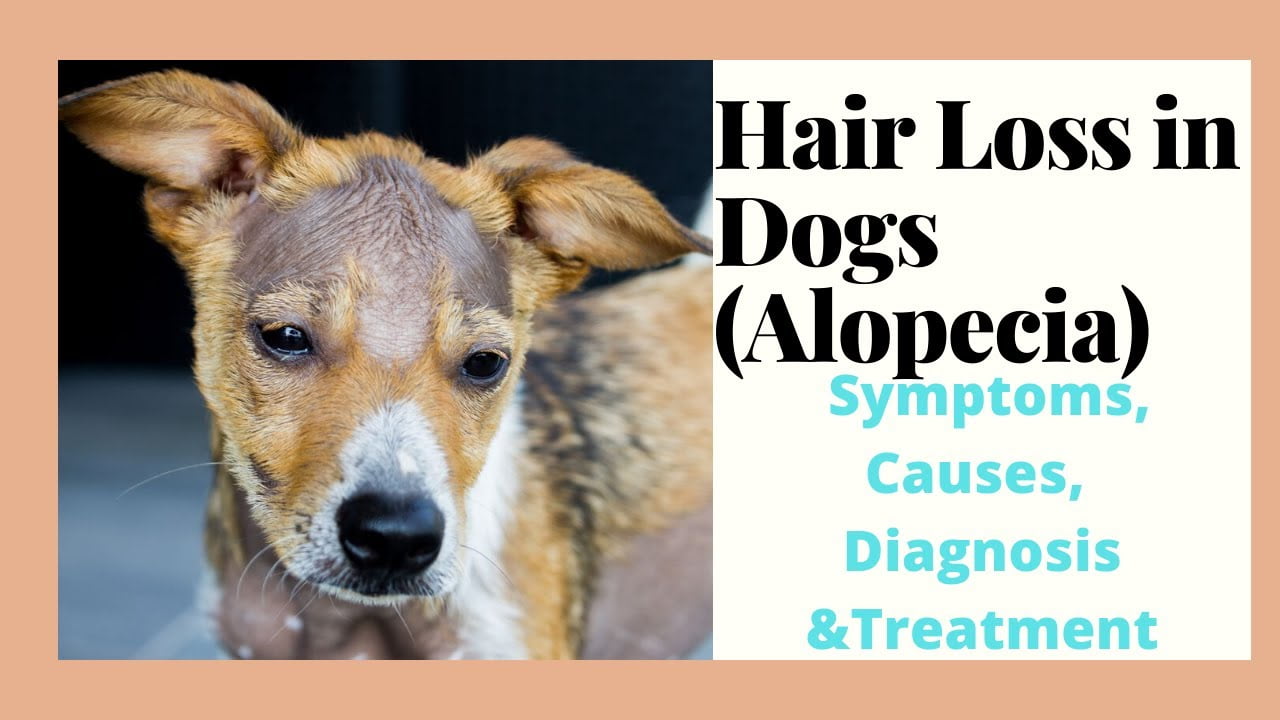As your puppy grows up, you may notice changes in his coat. If, however, your dog starts to lose patches of fur or if his coat seems to be thinning all over, it could be a sign of a problem – it could be alopecia. Alopecia is simply the medical term for hair loss and, in many cases, it is a symptom of an underlying condition. Keep reading to learn more about alopecia in dogs.
What Causes Alopecia in Dogs?

Though it most commonly refers to hair loss, alopecia actually covers a variety of changes to a dog’s coat including failure to grow or overall thinning. The most common cause for alopecia in dogs is an underlying medical condition such as Addison’s disease, hypothyroidism, allergies, or cancer.
Depending on the underlying cause, alopecia can be either gradual or acute – this simply means that it may come on slowly and worsen over time, or it may seem to happen all at once. Regardless the cause, alopecia is usually very noticeable in dogs, though it takes different forms such as bald circles or all-over hair loss. It may also be accompanied by inflammation or crusty, scaly skin.
There are many different causes for alopecia in dogs but the most common is mange – this is a condition caused by Demodex mites. A dog may also develop alopecia when the normal growth of hair is interrupted by something like an infection, trauma, immune disease, or hormonal abnormality. In cases where you notice multiple patches of hair loss, it may be due to inflammation of the hair follicles that leads to a disruption of hair growth. More widespread hair loss usually indicates some kind of disease such as ringworm or a bacterial infection.
Types of Dog Hair Loss

When it comes to hair loss in dogs, there are many different patterns which might be exhibited. In most cases, the pattern the hair loss follows is enough to suggest the cause of the hair loss, but that is not always the case. For example, patches of hair that has been chewed off near the base of the tail or along the inside of the legs is often an indication of flea infestation. Some of the most common patterns of hair loss in dogs include:
- All-over thinning of hair
- Thinning over the back and sides of the body
- Thinning over the ears
- Thinning along the neck
- Thinning under the belly
- Complete hair loss along the sides
- Circular bald patches
- Baldness on the abdomen
- Patches of baldness on the legs
- Balding over the scrotum at the back of the hind legs
Causes of Hair Loss in Dogs

Hair loss in dogs can be caused by a variety of different things:
- Allergic or contact dermatitis: An allergic reaction to certain substances or materials might cause skin irritation and hair loss. Common allergies include antibiotics, metals, plastic, chemicals, dyes, fragrances, and various plants.
- Alopecia areata: This is an autoimmune disorder which causes patches of hair loss on the dog’s body, neck, and head without itching.
- Bacterial infection: Hair loss caused by bacterial infection can be a secondary symptom related to a primary condition like an allergic or parasitic reaction.
- Cushing’s Disease: This disease is caused by an increase in corticosteroids in the body and it may cause hair loss, skin thinning, hyperpigmentation, and increased thirst and urination.
- Demodectic mange: This condition is caused by Demodex mites and it may result in hair loss, scaling, redness, ulcers, and sometimes darkening of the skin.
- Diabetes mellitus: This condition may compromise your dog’s immune system, making him more susceptible to infections and various skin conditions.
- Flea allergy dermatitis: Some dogs develop an allergic reaction to flea bites which may result in extreme itching, redness, hair loss, and scaliness.
Can Alopecia Be Treated?

The best treatment for alopecia can only be determined by the underlying cause. If the root cause is a bacterial infection, medicated shampoos or topical ointments may be beneficial. If alopecia is caused by an underlying condition like hypothyroidism, that condition needs to be treated first and, hopefully, the alopecia will resolve itself.
Because there are so many potential causes for alopecia in dogs, you need to have your vet diagnose the cause before you try any treatments. If you try an antibiotic ointment and the cause for the alopecia is hormonal, for instance, the treatment won’t work, and you could actually cause other problems for your dog. Do yourself and your dog a favor by getting an accurate diagnosis first and then start a course of treatment.

Once you have restored your dog’s coat to health, it is important that you maintain that health with proper grooming habits. Brush your dog at least a few times a week, depending how heavily he sheds. Not only will regular brushing help to reduce shedding, but it will also help to distribute the natural oils produced in his skin that help to keep his coat healthy. Avoid over-bathing your dog because you could dry out his skin and coat, and don’t use any products that aren’t approved for dogs.


![10 Question Banks Needed For ICAR AIEEA [Pdfs]](https://vetstudyhub.com/wp-content/uploads/2020/06/10-Question-Banks-Needed-For-ICAR-AIEEA-Pdfs-150x150.png)












Thank you for information Sir